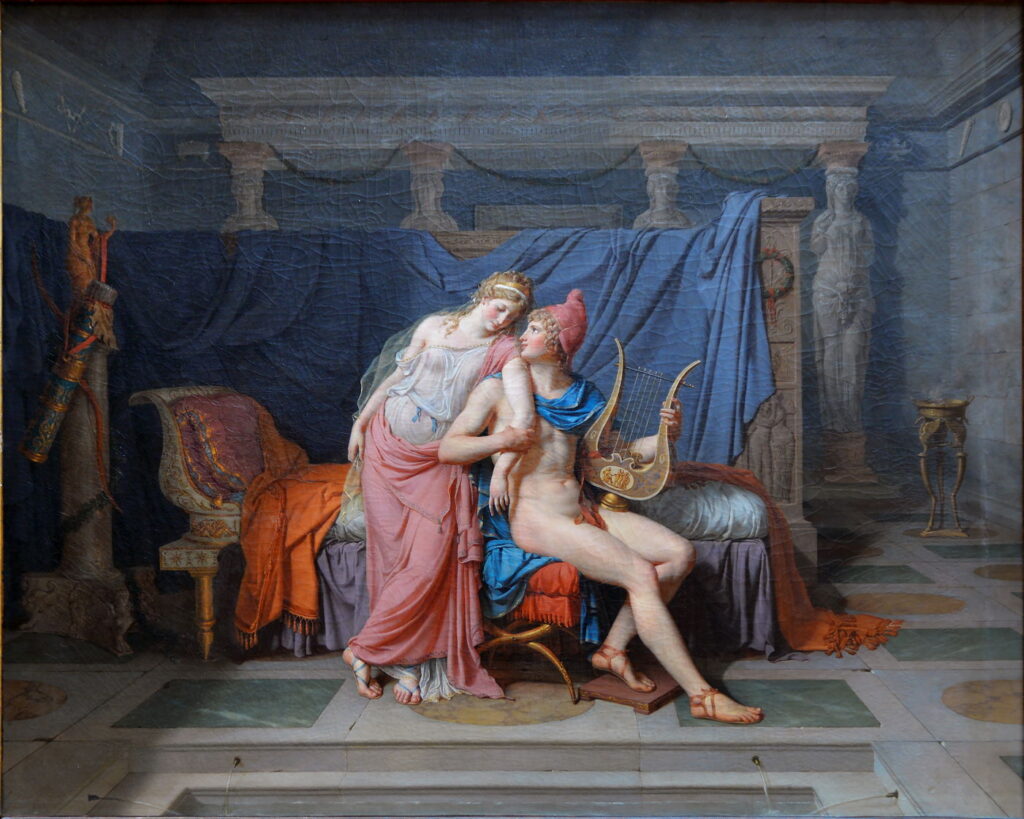Helen of Troy: victim or villain? 2

In the first of these two articles looking at the legendarily beautiful Helen, I had started to consider paintings of her abduction from her husband Menelaos, King of Sparta, by Paris Prince of Troy, the event that precipitated the Trojan War. Early depictions left no doubt that she was removed much in the way that Paris might have made off with some of the king’s other treasures.
Guido Reni (1575–1642), The Rape of Helen (c 1626-29), oil on canvas, 253 x 265 cm, Musée du Louvre, Paris. Wikimedia Commons.
By the seventeenth century, the painted story was changing. Guido Reni’s The Rape of Helen, from about 1626-29, shows Paris leading Helen away with her maids and courtiers in attendance. She doesn’t look at all happy, and is far from willing, and Eros stands with a finger raised as if warning that he will shortly be using his bow.
Juan de la Corte (1597–1660), The Rape of Helen (c 1620-50), oil on canvas, 150 × 222 cm, Museo Nacional del Prado, Madrid, Spain. Wikimedia Commons.
Juan de la Corte’s The Rape of Helen (c 1620-50) is also more ambiguous. Helen is being grasped around her waist by one of the Trojans, but seems to have resigned herself to her fate.
Benjamin West (1738–1820), Helen Brought to Paris (1776), oil on canvas, 143.3 x 198.3 cm, Smithsonian American Art Museum, Washington, DC. Wikimedia Commons.
By 1776, when Benjamin West painted Helen Brought to Paris, this has started to look consensual, although still a seduction by Paris. As he kneels before her in supplication, Aphrodite and her son Eros draw the figure of Helen towards him. Note how Helen is wearing predominantly white clothing, and unlike Aphrodite shows only a modest amount of flesh.
Gavin Hamilton (1723–1798), Venus Giving Helen to Paris as His Wife (1782-84), oil on canvas, 325 x 280 cm, Museo di Roma, Rome, Italy. Wikimedia Commons.
Gavin Hamilton’s painting of Venus Giving Helen to Paris as His Wife from 1782-84 moves closer to this as an elopement brokered by Aphrodite. Paris is on the left in Phrygian cap, as Aphrodite (behind) reveals Helen’s beauty. Three amorini are encouraging Helen to take more interest in Paris.
Angelica Kauffman (1741–1807), Venus Persuading Helen to Fall in Love with Paris (1790), oil on canvas, 102 × 127.5 cm, The Hermitage, St. Petersburg, Russia. Wikimedia Commons.
A few years later, Angelica Kauffman pursues a similar line in her Venus Persuading Helen to Fall in Love with Paris (1790). So maybe Paris didn’t have to abduct Helen after all, but Aphrodite and Eros had to persuade the queen to allow herself to be seduced.
Jacques-Louis David (1748–1825), The Love of Helen and Paris (1788), oil on canvas, 146 × 181 cm, Musée du Louvre, Paris. Image by Livioandronico2013, via Wikimedia Commons.
For Jacques-Louis David, it was all about The Love of Helen and Paris (1788). The couple pose in front of their bed with its rumpled sheets. He is naked and playing his lyre, his cheeks flushed. She wears diaphanous clothing that has slipped off her right shoulder, and her cheeks are distinctly flushed too. Watching over them is a small statue of Aphrodite.
Older Greek accounts make it clear that the couple made love before leaving the house of Menelaos, and that when they departed they took with them a substantial amount of valuable property.
Knowing they were at sea and heading back to Troy, Hera called up a storm, and their ships were blown to the east to reach Sidon in Phoenicia, where they obtained themselves some fine weavers, who accompanied them back to Troy. Once they were finally back in that city, the couple were married in a grand public ceremony, following which Helen assumed the role of Princess of Troy.
Gaston Bussière (1862–1928), Helen of Troy (1895), oil on canvas, dimensions not known, Musée des Ursulines de Mâcon, Mâcon, France. Image by Vassil, via Wikimedia Commons.
Gaston Bussière’s Helen of Troy (1895) poses against a backdrop of Troy before its fall, modelled after the great ancient cities of the Fertile Crescent in the Middle East. She wears an elaborate headdress with a band of peacock feathers, and her abundant jewellery is flashy rather than regal, more typical of a courtesan than a senior member of court.
Evelyn de Morgan (1855-1919), Helen of Troy (1898), oil on canvas, dimensions not known, De Morgan Centre, Guildford, England. Wikimedia Commons.
Evelyn de Morgan’s Helen of Troy (1898) admires herself in a mirror, the back of which bears the image of Aphrodite. Around her are white and red roses for love, and five white doves, two of which are ‘courting’. In the distance are the lofty towers of the fortified city.
It was the messenger of the gods Iris who reported Paris’s abduction of Helen to Menelaos when he was still on the island of Crete attending a funeral. He returned to Greece immediately and went to his brother Agamemnon, King of Mycenae, then travelled on to visit the wise Nestor of Gerenia, King of Pylos, who reminded Menelaos of historical (or mythological) precedents with varying degrees of relevance to his predicament. Nestor seems to have recommended Menelaos to accept what had happened, but his advice wasn’t heeded.
Still seething with anger against Paris and the Trojans, Menelaos invoked the Oath of Tyndareus, and started calling on Helen’s many unsuccessful suitors to defend him as a jilted husband, by joining an expedition against Troy.
Helen retained important roles during the Trojan War. After Agamemnon’s Greek forces had abandoned an attack on the city, and ran away, King Priam sent his men out from Troy to challenge them. Their leader Hector encouraged his brother Paris to settle the matter in a duel with Menelaos, with the winner taking Helen, once again treated as a prize for a contest.
Felix Jan Ferdinand Heyndrickx (1799-), Hector Censuring Helen and Paris (c 1820), oil on canvas, 121 x 148 cm, Princeton University Art Museum, Princeton, NJ. Image by Daderot, via Wikimedia Commons.
Felix Jan Ferdinand Heyndrickx, a former pupil of Jacques-Louis David, painted Hector Censuring Helen and Paris in about 1820. Paris is naked and sitting on an ornate bed holding Helen’s hand as Hector is clearly telling his wayward brother off.
Menelaos agreed, and had all but defeated his rival until Aphrodite intervened to rescue Paris and took him to bed Helen.
Towards the end of the war, when the Greeks were again struggling to make any headway, they were told that they would only capture the city with the aid of their master-archer Philoctetes and his bow of Heracles, who had been abandoned on the island of Lemnos following his snake-bite. Diomedes went to Lemnos and returned with Philoctetes and the bow of Heracles. Once his snake-bite had been healed, the archer took on Paris in combat, and his poisoned arrow sank deep into the Trojan’s flesh: he was dying.
Léon Cogniet (1794–1880), Oenone Refuses to Rescue Paris at the Siege of Troy (1816), oil on canvas, dimensions not known, Musée des Beaux-Arts, Fécamp, France. By VladoubidoOo, via Wikimedia Commons.
Fearing his imminent death, Paris pleaded with his former wife Oenone to heal him. But, as shown in Léon Cogniet’s Oenone Refuses to Rescue Paris at the Siege of Troy from 1816, she refused and left him to return to Helen and die. Oenone was then overcome with remorse and threw herself onto his funeral pyre. Cogniet shows the dying Paris, surrounded by warrior colleagues and looking imploringly towards Oenone, her back turned on him as she walks away. At the right edge, wearing a golden crown, is her successor, Queen Helen.
But Helen’s most important role in the late stages of the war is often overlooked. When the Trojans were duped into towing the wooden horse containing Greek commando forces into the city, it was Helen who enabled the success of their mission. As other Trojans went off to celebrate their victory with wine and feasting before falling into that deep sleep brought by intoxication, Helen switched sides and betrayed the Trojans.
With her torch, Helen stole up to the acropolis at the highest point of the city, and signalled to the Greek fleet that their ruse had worked, and their commandos were now inside the walls, and about to disgorge from their cramped quarters inside the horse. As the fleet sped back to Troy, the men from the horse took advantage of the full moon and the dead of night to kill the few guards, and throw the city’s gates open to welcome the massed Greek forces.
Myth and legend are undecided as to Helen’s ultimate fate, following the fall of Troy. Homer has her return to Menelaos in Sparta, and resume her former role as queen and mother, almost as if nothing had happened. Perhaps Euripides was closer to the truth in his Trojan Women, where she is shunned by the other women who survived the fall of Troy, and is eventually taken back to Greece to face a death penalty for her actions.
Gustave Moreau (1826-1898), Helen at the Scaean Gate (c 1880), oil on canvas, dimensions not known, Musée Gustave Moreau, Paris. Wikimedia Commons.
Gustave Moreau’s Helen at the Scaean Gate (c 1880) shows her faceless, standing amid the smoking ruins and rubble, which is perhaps the best place to leave her.
Reference
Wikipedia’s lengthy and well-referenced article about Helen.
